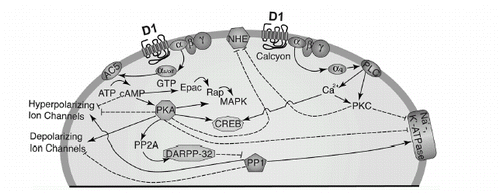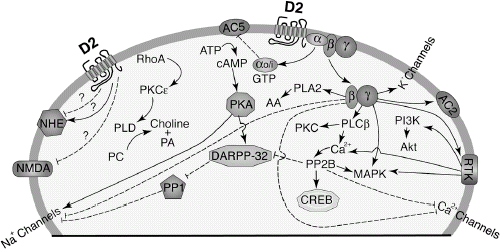Figures & data
Figure 1. D1-like receptor signaling pathways. Stimulatory effects are indicated with a solid line ending in an arrowhead, and inhibitory effects with a dashed line ending in a bar. Intervening steps (e.g., MAPKKK → MAPKK → MAPK) are frequently omitted from the figure for simplicity and ion channels are indicated generically, but are identified individually in . AC5, adenylate cyclase type 5; CREB, cyclic AMP response element binding protein; DARPP-32, dopamine-related phosphoprotein, 32 kDa; MAPK, mitogen-activated protein kinase; NHE, Na+/H+ exchanger; PKA, protein kinase A; PKC, protein kinase C; PLC, phospholipase C; PP1 or PP2A, protein phosphatase 1 or 2A.

Figure 2. Regulation of ion channels by D1-like (top) and D2-like (bottom) dopamine receptors. Stimulatory (solid line with arrowhead) or inhibitory (dashed line with bar) effects of dopamine receptors on GABA receptors (GABA), NMDA glutamate receptors (NMDA), AMPA glutamate receptors (AMPA), L- and N,P,Q-type Ca2+ channels, persistent (P) and transient (T) Na+ channels, G protein-regulated inwardly rectifying K+ channels (GIRK), and voltage-gated K+ channels (VGK+C) are schematically depicted, as well as whether the effect is thought to be mediated by protein kinase A (PKA), protein kinase C (PKC), G protein βγ subunits (Gβγ), or inhibition of the cyclic AMP/PKA pathway (↓PKA).

Figure 3. D2-like receptor signaling pathways. Stimulatory effects are indicated with a solid line ending in an arrowhead, and inhibitory effects with a dashed line ending with a bar. Intervening steps (e.g., MAPKKK → MAPKK → MAPK, or the multiple possible steps between Gβγ and RTK) are frequently omitted from the figure for simplicity. See for more specific description of ion channels. AA, arachidonic acid; AC2 or AC5, adenylate cyclase type 2 or 5; CREB, cyclic AMP response element-binding protein; DARPP-32, dopamine- and cyclic AMP-regulated phosphoprotein, 32 kDa; MAPK, mitogen-activated protein kinase; NHE, Na+/H+ exchanger; PA, phosphatidic acid; PC, phosphatidylcholine; PI3K, phosphatidylinositol 3-kinase; PKA, protein kinase A; PKC, protein kinase C; PLA2, phospholipase A2; PLC, phospholipase C; PLD, phospholipase D; PP1 or PP2A, protein phosphatase 1 or 2A; RTK, receptor tyrosine kinase.
